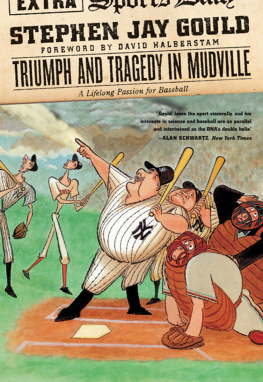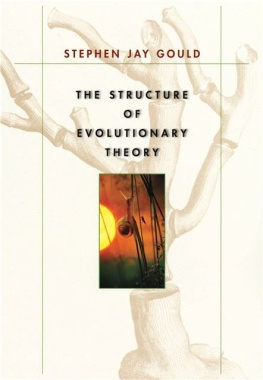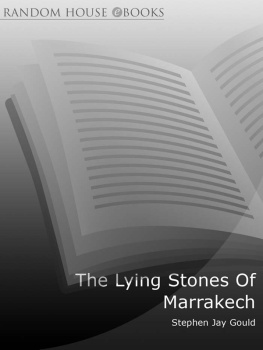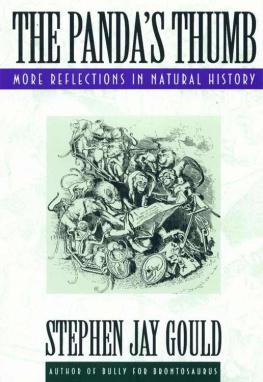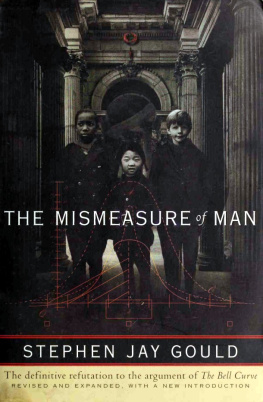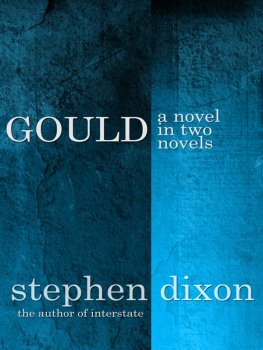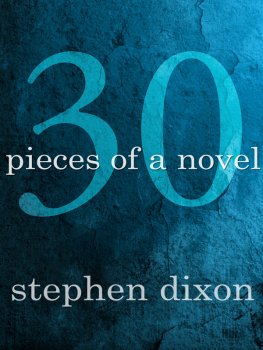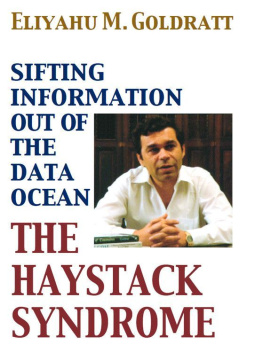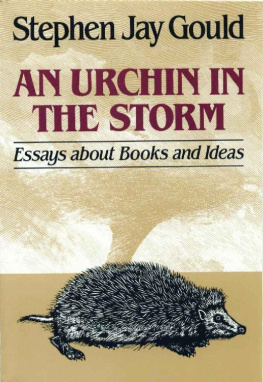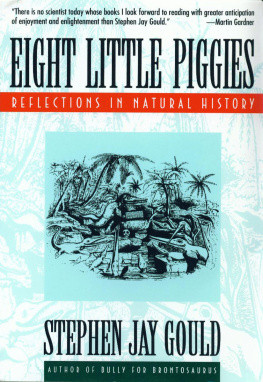Stephen Jay Gould - Dinosaur in a Haystack
Here you can read online Stephen Jay Gould - Dinosaur in a Haystack full text of the book (entire story) in english for free. Download pdf and epub, get meaning, cover and reviews about this ebook. year: 1995, genre: Romance novel. Description of the work, (preface) as well as reviews are available. Best literature library LitArk.com created for fans of good reading and offers a wide selection of genres:
Romance novel
Science fiction
Adventure
Detective
Science
History
Home and family
Prose
Art
Politics
Computer
Non-fiction
Religion
Business
Children
Humor
Choose a favorite category and find really read worthwhile books. Enjoy immersion in the world of imagination, feel the emotions of the characters or learn something new for yourself, make an fascinating discovery.
- Book:Dinosaur in a Haystack
- Author:
- Genre:
- Year:1995
- Rating:5 / 5
- Favourites:Add to favourites
- Your mark:
- 100
- 1
- 2
- 3
- 4
- 5
Dinosaur in a Haystack: summary, description and annotation
We offer to read an annotation, description, summary or preface (depends on what the author of the book "Dinosaur in a Haystack" wrote himself). If you haven't found the necessary information about the book — write in the comments, we will try to find it.
Dinosaur in a Haystack — read online for free the complete book (whole text) full work
Below is the text of the book, divided by pages. System saving the place of the last page read, allows you to conveniently read the book "Dinosaur in a Haystack" online for free, without having to search again every time where you left off. Put a bookmark, and you can go to the page where you finished reading at any time.
Font size:
Interval:
Bookmark:
Copyright 1995 by Stephen Jay Gould
All rights reserved
Printed in the United States of America
Published by arrangement with Harmony Books, an imprint of The Crown Publishing Group, a division of Random House, Inc.
First Harvard University Press edition, 2011.
Design by Cathryn S. Aison
Library of Congress Cataloging-in-Publication Data
Dinosaur in a haystack: reflections in natural history / Stephen Jay Gould.
1st Harvard University Press ed.
p. cm.
Originally published: New York: Harmony Books, c1995.
Includes bibliographical references and index.
ISBN 978-0-674-06160-6 (pbk : alk. paper)
1. Evolution (Biology). 2. Natural history. 1.Title.
Q11366.2.G659 2011 508-dc23
2011017923
For my only brother, Peter (1944-1994)
My dearest and constant companion
May we someday, somewhere, and somehow
live together in that two-family house
of our lifelong dreams.
MICHEL DE MONTAIGNE, traditional founder of the essay as a literary genre, wrote a short letter as a preface for his Essays (1580). He stated to the Readers:
I desire therein to be viewed as I appear in mine own genuine, simple and ordinary mannerIf I had lived among those nations, which (they say) yet dwell under the sweet liberty of natures primitive laws, I assure thee I would most willingly have painted myself quite fully and quite naked.
I have been writing the monthly essays that construct these books since January 1974. This volume, the seventh in a continuing series, includes the piece that I wrote to mark the completion of twenty years, with never a month missed. I should therefore use this preface to celebrate what our founder Montaigne defined as crucial to the genre in his statement quoted aboveordinary things (with deeper messages).
I have always seen myself as a meat-and-potatoes man. You can take your ravioli stuffed with quail andwell, stuff it somewhere (I am also quite capable of releasing my own ground pepper from a shaker). I wrote, in the preface to the first volume of this series (Ever Since Darwin, 1977), that I viewed myself as a tradesman, not a polymathand that my business was evolutionary biology.
As I have written with active passion, I have also watched with odd detachmentas my own essays have grown, shifted outward, and expanded focus throughout the seven volumes, across my own transition from rebellious youth to iconoclastic middle age. I trust that I have properly mixed my joy in new and challenging ideas with fierce fealty to the great and honorable traditions (not always followed, hence the need for iconoclasm) of the ancient and universal company of scholars (to cite the delightfully archaic line pronounced by Harvards president each year as he confers degrees upon new Ph.D.s). But still, the essays always come home to their centering theme of evolution, the most exciting and the most portentous natural truth that science has ever discoveredand surely as Freud noted in equating the most significant intellectual revolutions with the most troubling and penetrating assaults upon human arrogance, the most discombobulating intellectual change that science has ever compelled us to accept. What transition could be more profound than created in Gods image to rule a young world of stable entities made for our delectation to a fortuitous twig, budding but yesterday on an ancient and copious bush of ever changing, interrelated forms.
The first volume, Ever Since Darwin, covered the basic principles of Darwinian theory. The second, The Pandas Thumb, featured extensions and criticisms of these central ideas. The third, Hens Teeth and Horses Toes, expanded to the social implications of evolutionary thought, particularly to our professions struggle with oxymoronic creation science, then so threatening (we fought and won all the way to the Supreme Court), and now somewhat muted (though still dangerous), thanks to our vigilance and the power of our ideas and information. The fourth, The Flamingos Smile, stressed the random and unpredictable character of lifes history. The fifth, Bully for Brontosaurus, expanded this theme to a multifarious disquisition on the nature of history. Eight Little Piggies, the sixth volume, then added environmental subjects (curiously underplayed, I must say in self-criticism, in earlier contributions to the series).
This seventh volume, Dinosaur in a Haystack, features further extensions of evolutionary thought to subjects both primarily academic (literature, a personal love that has grown upon and through me over time, in parts 2 and 4; astronomy and calendrics, in continuity with a childhood passion that once ranked second only to paleontology, or maybe fourth after baseball and philately as well, in part 1) and primarily social and political (the vital role of museums in part 5, and the disparate faces of eugenics in part 6).
But I also remain true to my centering upon evolution in the two longest sections, treating the two great themes of my focal scienceevolutionary theory, with emphasis on issues in Darwinism (part 7), and patterns (often quite surprising and upsetting to traditional ideas) in the recorded history of life (part 3). In other words, process and pattern, or mechanism and pathway; the how and the what of evolutions four-billion-year course on our planet. Finally, and further true to my love of history (not only of life itself, but of science trying to understand life), I have illustrated many of my themes by their expression in the life and work of fascinating individuals, emphasizing either the unfairly unknown, or unappreciated byways in careers of celebrated people: Pierre-Simon Laplace, Mary Shelley, Alfred, Lord Tennyson, Jonathan Swift, Edgar Allan Poes work on shells, the unknown Mary Roberts, the equally unknown Gotthelf Fischer von Waldheim, Luther Burbank, R.A. Fischer, and J.B.S. Haldane. In the books last section of three essays, I explore some wonderful connections between Linnaeus and Erasmus Darwin, with inevitable comments on Erasmuss far more famous grandson.
My dinosaur in a haystack may represent the gem of a detail always sought to ground a generality, dinosaurs as the champion details for public fascination, the haystack as an encompassing generality, And there conjunction as the secret to a successful essay in Montaignes original and defining strategythe marriage of alluring detail with constructive generality, all told with the stamp of an authors personal involvement.
I am not a modest man, but I do know my great weaknesses amidst one lucky strength. I am not innumerate, but how I wish for the mathematical creativity, a pure blank for me, that drives so many scientists to find accomplishment. I am not illogical, but how I yearn for the awesome ability I note in many colleagues to identify, develop, and test the linear implications of an argument.
All people have oddly hypertrophied skills, but some folks never identify their uniqueness properly; for others, the specialness doesnt integrate into professional life and becomes, at best, a recreation or a party trick. I did receive one great gift from natures preeminent goddess, Fortunaa happy conjunction of my own hypertrophy with maximal utility in a central professional activity. I cannot forget or expunge any item that enters my head, and I can always find legitimate and unforced connections among the disparate details. In this sense, I am an essay machine; cite me a generality, and I will give you six tidbits of genuine illustration.A detail, by itself, is blind; a concept without a concrete illustration is empty. The conjunction defines the essay as a genre, and I draw connections in a manner that feels automatic to me.
But Fortunas gifts languish unless reinforced by her sister Diligencia under the patronage of Amor. I am past fifty, but I retain every atom of the enthusiasm in my five-year-old self for any item of knowledge. I love to learn the details and the reasons of peoples lives and natures ways. I yearn to encounter these items in their original languages and first presentations, not through someone elses distillation. I do not believe in vicarious pleasure and will go to ridiculous lengths to stand on the right spot, or hold the object itself.
Font size:
Interval:
Bookmark:
Similar books «Dinosaur in a Haystack»
Look at similar books to Dinosaur in a Haystack. We have selected literature similar in name and meaning in the hope of providing readers with more options to find new, interesting, not yet read works.
Discussion, reviews of the book Dinosaur in a Haystack and just readers' own opinions. Leave your comments, write what you think about the work, its meaning or the main characters. Specify what exactly you liked and what you didn't like, and why you think so.



